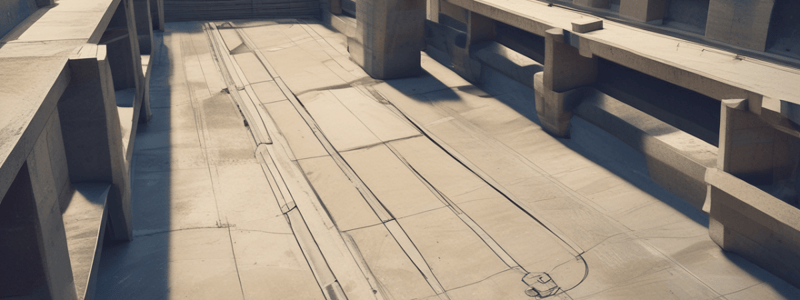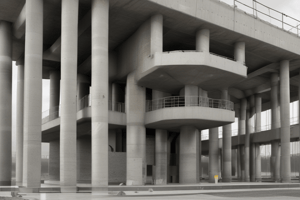Podcast
Questions and Answers
What is the primary property of cement?
What is the primary property of cement?
- Chemical reaction with air
- Adhesive and cohesive properties (correct)
- Water absorbency
- Electrical conductivity
What is Portland cement primarily made of?
What is Portland cement primarily made of?
- Sand and gravel
- Granite and marble
- Gypsum and shale
- Calcareous material, alumina, and silica (correct)
What type of cements are used in making concrete?
What type of cements are used in making concrete?
- Hydraulic cements (correct)
- Slow-setting cements
- Fast-setting cements
- Non-hydraulic cements
Who is attributed with the invention of Portland cement?
Who is attributed with the invention of Portland cement?
When did Joseph Aspdin take the patent for Portland cement?
When did Joseph Aspdin take the patent for Portland cement?
Why was Portland cement named as such?
Why was Portland cement named as such?
What was the process used by Joseph Aspdin to create Portland cement?
What was the process used by Joseph Aspdin to create Portland cement?
What was the result of Joseph Aspdin's process of creating Portland cement?
What was the result of Joseph Aspdin's process of creating Portland cement?
How have ancient civilizations used cementing materials?
How have ancient civilizations used cementing materials?
What percentage of the material becomes liquid in the hottest part of the kiln?
What percentage of the material becomes liquid in the hottest part of the kiln?
What is the size range of the balls formed in the kiln?
What is the size range of the balls formed in the kiln?
Why is gypsum added to the cooled clinker?
Why is gypsum added to the cooled clinker?
What is the main difference in water content between the wet and dry processes?
What is the main difference in water content between the wet and dry processes?
What is a comparison between the wet and dry processes in terms of fuel consumption?
What is a comparison between the wet and dry processes in terms of fuel consumption?
What is an advantage of the dry process compared to the wet process?
What is an advantage of the dry process compared to the wet process?
What is a disadvantage of the dry process compared to the wet process?
What is a disadvantage of the dry process compared to the wet process?
What are the main raw materials used in the manufacture of cement?
What are the main raw materials used in the manufacture of cement?
What is the final product of the kiln formed into balls?
What is the final product of the kiln formed into balls?
What is the primary factor that influences the properties of cement?
What is the primary factor that influences the properties of cement?
Who is credited with identifying the major compounds in Portland cement?
Who is credited with identifying the major compounds in Portland cement?
What is the process called when the oxides combine at high temperature in the kiln?
What is the process called when the oxides combine at high temperature in the kiln?
What are the four major compounds in Portland cement?
What are the four major compounds in Portland cement?
What is the name given to the calculation of the potential composition of Portland cement?
What is the name given to the calculation of the potential composition of Portland cement?
What are the two minor compounds of particular interest in Portland cement?
What are the two minor compounds of particular interest in Portland cement?
What is the primary function of the kiln in cement production?
What is the primary function of the kiln in cement production?
What is the name given to the complex compounds formed in the kiln?
What is the name given to the complex compounds formed in the kiln?
What are the oxides of sodium and potassium known as in Portland cement?
What are the oxides of sodium and potassium known as in Portland cement?
What is the primary characteristic of rapid-hardening Portland cement?
What is the primary characteristic of rapid-hardening Portland cement?
What is the main difference between rapid-hardening and ordinary Portland cement?
What is the main difference between rapid-hardening and ordinary Portland cement?
Why should rapid-hardening Portland cement not be used in mass concrete construction?
Why should rapid-hardening Portland cement not be used in mass concrete construction?
What is the benefit of using rapid-hardening Portland cement in cold weather concrete?
What is the benefit of using rapid-hardening Portland cement in cold weather concrete?
What is the primary reason for using low heat Portland cement in mass concrete construction?
What is the primary reason for using low heat Portland cement in mass concrete construction?
What is the main difference between rapid-hardening and low heat Portland cement?
What is the main difference between rapid-hardening and low heat Portland cement?
What is the result of the higher fineness of rapid-hardening Portland cement?
What is the result of the higher fineness of rapid-hardening Portland cement?
What is the recommended use of rapid-hardening Portland cement?
What is the recommended use of rapid-hardening Portland cement?
What is the main characteristic of ASTM Type III cements?
What is the main characteristic of ASTM Type III cements?
What is the result of calcium hydroxide reacting with sulphates in soils or water?
What is the result of calcium hydroxide reacting with sulphates in soils or water?
What is the primary advantage of calcium hydroxide in concrete?
What is the primary advantage of calcium hydroxide in concrete?
What is the structure of hydrated cement at the macro level?
What is the structure of hydrated cement at the macro level?
What is the transition zone in concrete?
What is the transition zone in concrete?
What is the effect of drying shrinkage or temperature variation on the transition zone?
What is the effect of drying shrinkage or temperature variation on the transition zone?
What happens to the microcracks in the transition zone when the structure is loaded at high stress levels?
What happens to the microcracks in the transition zone when the structure is loaded at high stress levels?
Why does concrete fail at a lower stress level than the strength of bulk paste or aggregate?
Why does concrete fail at a lower stress level than the strength of bulk paste or aggregate?
What is the composition of fresh cement paste?
What is the composition of fresh cement paste?
What happens to the quantity of unhydrated cement in the paste with the lapse of time?
What happens to the quantity of unhydrated cement in the paste with the lapse of time?
Flashcards are hidden until you start studying
Study Notes
Cement
- Cement is a material with adhesive and cohesive properties that bonds mineral fragments into a compact whole.
- Portland cement is made primarily from calcareous material, such as limestone or chalk, and from alumina and silica found as clay or shale.
Historical Background
- The history of cementing material is as old as the history of engineering construction.
- Egyptians, Romans, and Indians used cementing materials in their ancient constructions.
- Joseph Aspdin, a Leeds builder and bricklayer, patented Portland cement in 1824.
Manufacturing Process
- The manufacturing process involves mixing and grinding hard limestones and finely divided clay into a slurry, which is then calcined in a furnace.
- The mixture undergoes a series of chemical reactions, and the resulting clinker is interground with gypsum to prevent flash-setting.
- There are two main processes: wet process and dry process, which differ in the amount of water used and the heat required.
Chemical Composition of Portland Cement
- The raw materials used for the manufacture of cement consist mainly of lime, silica, alumina, and iron oxide.
- These oxides interact with each other in the kiln at high temperature to form more complex compounds.
- The relative proportions of these oxide compositions influence the properties of cement.
Bogue's Compounds
- The major compounds formed in the kiln are: C3S, C2S, C3A, and C4AF.
- The calculation of the potential composition of Portland cement is based on the work of R.H. Bogue.
Structure of Hydrated Cement
- Concrete is considered as a two-phase material: paste phase and aggregates phase.
- The transition zone, which is the interfacial region between the particles of coarse aggregate and hardened cement paste, is a plane of weakness.
- The transition zone develops microcracks due to drying shrinkage or temperature variation, which can lead to failure of bond.
Types of Portland Cement
- Rapid-hardening Portland cement (Type III) develops strength more rapidly and has a higher C3S content and a finer grinding of the cement clinker.
- Low heat Portland cement (Type IV) has a lower rate of heat evolution, making it suitable for mass concrete construction.
Studying That Suits You
Use AI to generate personalized quizzes and flashcards to suit your learning preferences.



